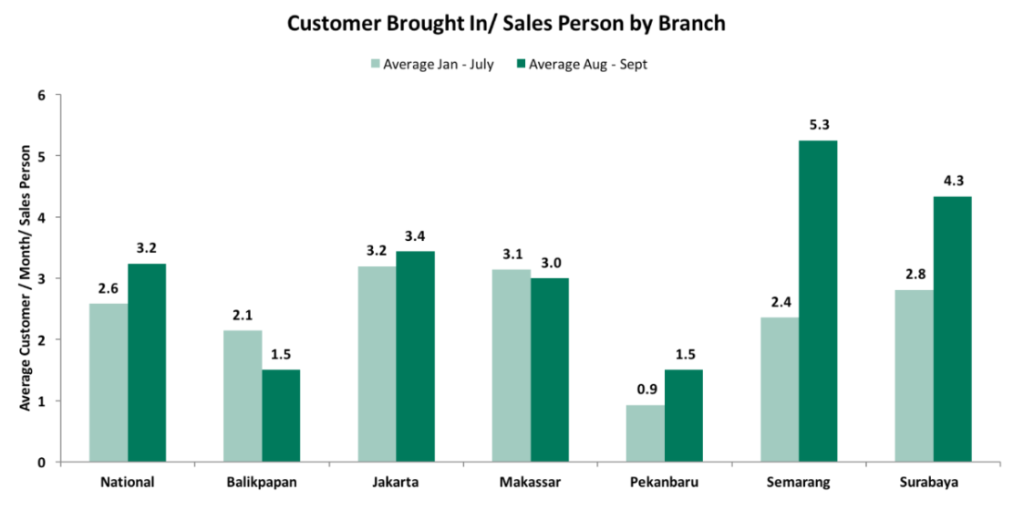At a Glance
Renoir designed a 20-week project to improve a client’s sale and collection productivity. As a result, the following results were seen:
- A 26% improvement in sales productivity during the first two months after implementing the new way of working.
- Improved communication between front-end and back-end operations through weekly review meetings.
- Centralised monitoring and control from the head office for key operational risk that needed to be managed by the branch staff.
Background
The client is a finance company in Indonesia which operates in leasing, consumer financing and factoring. It was established in the 1980s and its strategy is to compete in the niche market of financing productive sectors. It also aims to start a consumer financing business using alternative delivery channels such as fintech.
The Challenge
Renoir was engaged to analyse the client’s current operating model, Sales and Collection productivity levels and the effectiveness of existing processes and control system.
Some of the main findings were:
- The client did not have a unique value proposition to the customers that would help them to differentiate itself against competitors.
- The sales and collection funnel was not properly measured and managed proactively resulting in low productivity and results.
- There was very little visibility on the activities performed by each salesperson and collector.
- The Management Control Systems for sales and collection did not fit their purposes. They had poor planning, lack of follow-ups and control, and reporting was focused on outcome rather than how to most efficiently and effectively achieve the desired results.
- There was a need to simplify the work being done and reduce levels of bureaucracy.
What We Did
The Renoir team designed a 20-week programme which was divided into six work packages with clear objective and deliverables.
1. Definition, Value Mapping, Linkages, Alignment to Strategy
- Current ‘as-is’ ways of working in relevant departments were defined and reviewed.
- Alignment of ‘as-is’ ways of working was reviewed with management strategy.
2. Alignment to Best Practices
- • Best practices to fit the organisational strategy were defined and reviewed.
3. Management Interview
- Management interviews were conducted to obtain the client’s feedback and input on current ‘as-is’ ways of working and to collect their input on what changes were required.
4. Management Culture Questionnaire
- Staff feedback and input was analysed against management culture set.
5. Development & Review of White Paper
- We worked with the client to design and define a White Paper with ‘to-be’ ways of working
- Tools and templates were detailed for the new ways of working.
- Key stakeholders & management were consulted for their feedback & input.
6. Implementation Phase
- Implement White paper to the relevant branches / departments.
- Conduct on-the-job coaching.
- Conduct Situational Audits for behavior change.

How Market Share Rose by 125% with a New MCS: Case Study

Boost marketing effectiveness with optimal branch processes

How Market Share Rose by 125% with a New MCS: Case Study

Boost marketing effectiveness with optimal branch processes
Project Structure
Under Renoir’s full-time guidance, a ‘Taskforce’ team of 3 client staff was formed to help drive and sustain the implementation of the work packages. A Management Action Team (MAT) was set up which was comprised of all the mid-level managers of the organisation. The MAT structure was the key driving force in creating change through revised processes & control systems and defining the behavior expected of staff.
A Steering Committee was formed to oversee the program made up of senior Group leaders, MAT leaders and Renoir management. They held bi-weekly meetings to review the progress of solution design, implementation, behaviour change and program results. To ensure buy-in and ownership across the operational level, brainstorming and feedback sessions were conducted throughout the design and implementation phases, giving people the chance to participate, contribute and have their concerns and ideas heard and considered in the final organisational design and structuring of the management control systems.
The program’s main impact was the implementation of a New Way of Working for both the Sales and Collection teams that focused on productivity and controls. Operationally, the programme has also implemented various improved processes, procedures and controls to help the organisation to improve on speed and simplicity as their core value proposition to the customers. Centralised controls from the head office also help the organisation to efficiently manage and reduce the operational risks at their branch levels.
One of the key success factors used to drive the sustainability of the change process was the introduction of behavior auditing. Systematic audits were developed and implemented periodically to ensure that the new structure and new way of working were understood and that all staff were able to increase their productivity.
The Results
Quantitative
With the implementation of a sales dashboard and reporting, we were able to measure and monitor sales productivity more easily. There was a 26% improvement in sales productivity during the first two months after implementing the new way of working.
Behavioural Change
The following behavioural changes were also seen as results from the project:
- A more structured way of working for both Salesperson and Collector emphasising productivity improvement.
- Centralised monitoring and control from the head office for key operational risk that needed to be managed by the branch staff.
- Focus was placed on speed and simplicity as the core customer value proposition.
- Improved communication between front-end and back-end operations through weekly review meetings.
Implement new ways of working with behavioural change.











